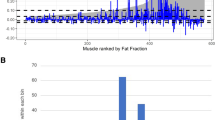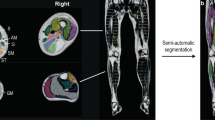Abstract
There is no effective treatment available for facioscapulohumeral muscular dystrophy type 1 (FSHD1), but emerging therapies are under way that call for a better understanding of natural history in this condition. In this prospective, longitudinal study, we used quantitative MRI to assess yearly disease progression in patients with FSHD1. Ambulatory patients with confirmed diagnosis of FSHD1 (25/20 men/women, age 20–75 years, FSHD score: 0–12) were tested with 359–560-day interval between tests. Using the MRI Dixon technique, muscle fat replacement was evaluated in paraspinal, thigh, and calf muscles. Changes were compared with those in FSHD score, muscle strength (hand-held dynamometry), 6-minute-walk-distance, 14-step-stair-test, and 5-time-sit-to-stand-test. Composite absolute fat fraction of all assessed muscles increased by 0.036 (CI 0.026–0.046, P < 0.001), with increases in all measured muscle groups. The clinical severity FSHD score worsened (10%, P < 0.05), muscle strength decreased over the hip (8%), neck (8%), and back (17%) (P < 0.05), but other strength measures, 6-minute-walk-distance, 5-times-sit-to-stand-test, and 14-step-stair-test were unchanged. Changes in muscle strength, FSHD score, and fat fraction did not correlate. This first study to systemically monitor quantitative fat replacement longitudinally in FSHD1 shows that MRI provides an objective measure of disease progression, often before changes can be appreciated in strength and functional tests. The study indicates that quantitative MRI can be a helpful end-point in follow-up and therapeutic trials of patients with FSHD1.






Similar content being viewed by others
References
Tawil R, Kissel JT, Heatwole C et al (2015) Evidence-based guideline summary: evaluation, diagnosis, and management of facioscapulohumeral muscular dystrophy Report of the Guideline Development, Dissemination, and Implementation Subcommittee of the American Academy of Neurology and the Practice Issues Review Panel of the American Association of Neuromuscular & Electrodiagnostic Medicine. Neurology 85:357–364. doi:10.1212/WNL.0000000000001783
Tawil R, van der Maarel SM, Tapscott SJ (2014) Facioscapulohumeral dystrophy: the path to consensus on pathophysiology. Skelet Muscle 4:12. doi:10.1186/2044-5040-4-12
Dahlqvist JR, Vissing CR, Thomsen C, Vissing J (2014) Severe paraspinal muscle involvement in facioscapulohumeral muscular dystrophy. Neurology 83:1178–1183. doi:10.1212/WNL.0000000000000828
Sookhoo S, Mackinnon I, Bushby K et al (2007) MRI for the demonstration of subclinical muscle involvement in muscular dystrophy. Clin Radiol 62:160–165. doi:10.1016/j.crad.2006.08.012
Dixon WT (1984) Simple proton spectroscopic imaging. Radiology 153:189–194. doi:10.1148/radiology.153.1.6089263
Ma J (2008) Dixon techniques for water and fat imaging. J Magn Reson Imaging JMRI 28:543–558. doi:10.1002/jmri.21492
Willis TA, Hollingsworth KG, Coombs A et al (2013) Quantitative muscle MRI as an assessment tool for monitoring disease progression in LGMD2I: a multicentre longitudinal study. PLoS One 8:e70993. doi:10.1371/journal.pone.0070993
Lamperti C, Fabbri G, Vercelli L et al (2010) A standardized clinical evaluation of patients affected by facioscapulohumeral muscular dystrophy: the FSHD clinical score. Muscle Nerve 42:213–217. doi:10.1002/mus.21671
Andersen G, Prahm KP, Dahlqvist JR et al (2015) Aerobic training and postexercise protein in facioscapulohumeral muscular dystrophy: RCT study. Neurology 85:396–403. doi:10.1212/WNL.0000000000001808
van der Kooi EL, Vogels OJM, van Asseldonk RJGP et al (2004) Strength training and albuterol in facioscapulohumeral muscular dystrophy. Neurology 63:702–708
Wagner KR, Fleckenstein JL, Amato AA et al (2008) A phase I/IItrial of MYO-029 in adult subjects with muscular dystrophy. Ann Neurol 63:561–571. doi:10.1002/ana.21338
Kissel JT, McDermott MP, Mendell JR et al (2001) Randomized, double-blind, placebo-controlled trial of albuterol in facioscapulohumeral dystrophy. Neurology 57:1434–1440
Statland JM, McDermott MP, Heatwole C et al (2013) Reevaluating measures of disease progression in facioscapulohumeral muscular dystrophy. Neuromuscul Disord NMD 23:306–312. doi:10.1016/j.nmd.2013.01.008
Eichinger K, Heatwole C, Heininger S et al (2016) Validity of the six minute walk test in facioscapulohumeral muscular dystrophy. Muscle Nerve. doi:10.1002/mus.25251
Kan HE, Scheenen TWJ, Wohlgemuth M et al (2009) Quantitative MR imaging of individual muscle involvement in facioscapulohumeral muscular dystrophy. Neuromuscul Disord 19:357–362. doi:10.1016/j.nmd.2009.02.009
Fischmann A, Hafner P, Fasler S et al (2012) Quantitative MRI can detect subclinical disease progression in muscular dystrophy. J Neurol 259:1648–1654. doi:10.1007/s00415-011-6393-2
Regula JU, Jestaedt L, Jende F et al (2015) Clinical muscle testing compared with whole-body magnetic resonance imaging in facioscapulohumeral muscular dystrophy. Clin Neuroradiol. doi:10.1007/s00062-015-0386-y
Leung DG, Carrino JA, Wagner KR, Jacobs MA (2015) Whole-body magnetic resonance imaging evaluation of facioscapulohumeral muscular dystrophy. Muscle Nerve 52:512–520. doi:10.1002/mus.24569
Janssen B, Voet N, Geurts A et al (2016) Quantitative MRI reveals decelerated fatty infiltration in muscles of active FSHD patients. Neurology. doi:10.1212/WNL.0000000000002640
Tasca G, Monforte M, Iannaccone E et al (2014) upper girdle imaging in facioscapulohumeral muscular dystrophy. PLoS One. doi:10.1371/journal.pone.0100292
Friedman SD, Poliachik SL, Otto RK et al (2014) Longitudinal features of STIR bright signal in FSHD. Muscle Nerve 49:257–260. doi:10.1002/mus.23911
Janssen BH, Voet NBM, Nabuurs CI et al (2014) Distinct disease phases in muscles of facioscapulohumeral dystrophy patients identified by MR detected fat infiltration. PLoS One. doi:10.1371/journal.pone.0085416
Lareau-Trudel E, Le Troter A, Ghattas B et al (2015) Muscle quantitative mr imaging and clustering analysis in patients with facioscapulohumeral muscular dystrophy type 1. PLoS One. doi:10.1371/journal.pone.0132717
Frisullo G, Frusciante R, Nociti V et al (2011) CD8+ T cells in facioscapulohumeral muscular dystrophy patients with inflammatory features at muscle MRI. J Clin Immunol 31:155–166. doi:10.1007/s10875-010-9474-6
Tasca G, Pescatori M, Monforte M et al (2012) Different molecular signatures in magnetic resonance imaging-staged facioscapulohumeral muscular dystrophy muscles. PLoS One. doi:10.1371/journal.pone.0038779
Tasca G, Monforte M, Ottaviani P et al (2016) Magnetic resonance imaging in a large cohort of facioscapulohumeral muscular dystrophy patients: pattern refinement and implications for clinical trials. Ann Neurol. doi:10.1002/ana.24640
Morrow JM, Sinclair CDJ, Fischmann A et al (2016) MRI biomarker assessment of neuromuscular disease progression: a prospective observational cohort study. Lancet Neurol 15:65–77. doi:10.1016/S1474-4422(15)00242-2
Dahlqvist JR, Vissing CR, Hedermann G et al (2016) Fat replacement of paraspinal muscles with aging in healthy adults. Med Sci Sports Exerc. doi:10.1249/MSS.0000000000001119
Baum T, Inhuber S, Dieckmeyer M et al (2016) Association of quadriceps muscle fat with isometric strength measurements in healthy males using chemical shift encoding-based water-fat magnetic resonance imaging. J Comput Assist Tomogr 40:447–451. doi:10.1097/RCT.0000000000000374
Acknowledgements
We thank Poul Henrik Frandsen, radiologist, Department of Diagnostic Radiology, Rigshospitalet, for his helpful advice setting up the MRI-protocol.
Author information
Authors and Affiliations
Corresponding author
Ethics declarations
Study funding
The study was conducted using the hospital facilities without external financial or material support.
Conflicts of interest
Dr. J Vissing has received research and travel support and speaker honoraria from Genzyme/Sanofi and Ultragenyx Pharmaceuticals and served as consultant on advisory boards of Genzyme/Sanofi, Lundbeck, Ultragenyx Pharmaceuticals, NOVO Nordisk, and Alexion Pharmaceuticals. Dr. G Andersen, Dr. JR Dahlqvist, Dr. CR Vissing, Dr. K Heje, and Dr. C Thomsen report no disclosures.
Rights and permissions
About this article
Cite this article
Andersen, G., Dahlqvist, J.R., Vissing, C.R. et al. MRI as outcome measure in facioscapulohumeral muscular dystrophy: 1-year follow-up of 45 patients. J Neurol 264, 438–447 (2017). https://doi.org/10.1007/s00415-016-8361-3
Received:
Revised:
Accepted:
Published:
Issue Date:
DOI: https://doi.org/10.1007/s00415-016-8361-3




